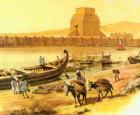Reserve, National Park of Greece. What to see
National parks Greece are located throughout the country. Vikos Aoos is in the west. Here the Pindus Mountains stretch for almost 200 km, separating Epirus and Thessaly. In 1973, on this territory for protection natural wealth ancient land The National Park was formed.
Natural wonders in Vikos Aoos
The area of the park is 126 sq. km. Amazing discoveries await tourists everywhere. Here is the Vikos gorge, which is even listed in the most famous Guinness Book of Records! It is larger in size than the famous one! The depth of Vikos is more than 1 kilometer.

There is also the huge Aoos ravine, part of Zagori, and the picturesque Timfi mountain range. The Voidomatis River, which flows along the bottom of a deep gorge, has been involved for thousands of years in the creation of this natural miracle, the length of which reaches 12 kilometers! A river with the same name flows in the Aoos ravine.
There are many beautiful lakes located in National Parks. Vikos-Aoos is no exception. Dragon Lake is of great interest. It is home to very rare animals – Alpine newts. Local residents believe that they are the descendants of fire-breathing dragons who, according to legend, once lived next to this beautiful lake.
Rich flora of the National Park
The diversity of ecosystems in Vikos Aoos is due to the diversity of the terrain. There are mountains and valleys, rivers and lakes, hills and forests. The plants in the park are very diverse. There are flowers, herbs, many of which are medicinal, as well as coniferous and deciduous trees. A rare species grows in the protected area: black pine.
You can find lindens, maples, arbutus, massive holm oak, coniferous trees. The protected area of the park makes it possible to preserve rare plant species, because the adjacent part of the area suffers greatly from human activity. And this despite the fact that the population density is very low.

Fauna of the National Park
The fauna in Vikos-Aoos is very rich. Animals and birds, fish and reptiles live here. Mountain rivers abound in fish. The trout population is especially large. Many birds of prey live on high rocky ledges. In the forests and mountains there are red deer, fast mountain goats, cunning lynxes, rare species wild cat. There are also wild boars, wolves, foxes, marmots, and otters.
A rare species has been preserved in Zagorje: the Greek brown bear. Unfortunately, it is in danger of extinction. Scientists estimate that only about 200 individuals live in these mountains. It is only thanks to the creation of the National Protected Area that the Greek bear community still exists on Earth.
National parks in Greece, including Vikos-Aoos, give guests of the country an excellent opportunity to see picturesque places and breathe cleanest air and completely immerse yourself in the enchanting world of beautiful Greece, rich in incredible natural wonders.
National parks of Greece. Vikos-Aoos photo











Greece is fragmented into small land areas and has many ecosystems. The bulk of the population - almost two thirds - lives in large cities near the coast. Tourist flows are directed to these same places, increasing during the holiday season. The pressure on fragile ecosystems is also increasing. Due to the intensive use of natural resources in the country, security zones, reserves, parks, forests and reserves. They help maintain ecological balance. The Greeks are very sensitive to pristine nature native land, as well as to historical monuments. National parks of Greece are natural attractions of the country that are of interest to tourists and vacationers.
 During your holiday in Greece, you will hear more than once about the twelve gods of Olympus, who were part of the Greek pantheon. All of them lived on the highest mountain range, which is now located in the UNESCO-protected territory of Olympus National Park. The park is located in the east of the mainland, near Thessaloniki, in the region of Thessaly. It was opened in 1938 and covers an area of 3,933 hectares. Every year, those who wish take long walks and conquer the peaks, admiring the stunning views from the heights. IN natural complex includes mountain rivers, gorges, deciduous and coniferous trees, which saturate oxygen with freshness and healing aroma. Alpine valleys lie above the forest level. Calcareous soil absorbs excess moisture and makes the climate drier than on the coast.
During your holiday in Greece, you will hear more than once about the twelve gods of Olympus, who were part of the Greek pantheon. All of them lived on the highest mountain range, which is now located in the UNESCO-protected territory of Olympus National Park. The park is located in the east of the mainland, near Thessaloniki, in the region of Thessaly. It was opened in 1938 and covers an area of 3,933 hectares. Every year, those who wish take long walks and conquer the peaks, admiring the stunning views from the heights. IN natural complex includes mountain rivers, gorges, deciduous and coniferous trees, which saturate oxygen with freshness and healing aroma. Alpine valleys lie above the forest level. Calcareous soil absorbs excess moisture and makes the climate drier than on the coast.

Depending on the elevation, different microclimatic zones “rule the show” in the park, responsible for vegetation and fauna. This is due to the natural diversity of flora and fauna. On forest walks you can meet foxes, lynxes, mountain goats, deer, mouflons and other inhabitants of the park. More than one and a half thousand species of plants, 32 species of mammals, 136 species of birds, reptiles, insects - such a concentration contributes to the survival and preservation of plants and animals, a real earthly paradise! In 1981, Olympus Park was officially declared a national biosphere reserve.
Vacationers and tourists from Athens, Thessaloniki, Larissa, Ioannina and other points come to the park. Well-developed road infrastructure, tourist and walking routes, equipped  vacation spots. For lovers active recreation this is probably the best place. The four peaks of the mountain range beckon climbers. The highest mountain is Olympus, its height is 2,917 meters. The lowest point reaches 2,866 meters. The third largest peak, Stephanie, is called the “throne of Zeus.” Professionals conquer the mountains on their own; there are lifts and safe trails for beginners. In addition to mountaineering, vacationers take long one- and two-day walks in the forests and valleys of the park. Hiking expeditions provide an excellent opportunity to explore the nature of the continent, get acquainted with forest inhabitants and admire the beautiful scenery. There are shelters and campsites for vacationers at different points in the Olympus National Park.
vacation spots. For lovers active recreation this is probably the best place. The four peaks of the mountain range beckon climbers. The highest mountain is Olympus, its height is 2,917 meters. The lowest point reaches 2,866 meters. The third largest peak, Stephanie, is called the “throne of Zeus.” Professionals conquer the mountains on their own; there are lifts and safe trails for beginners. In addition to mountaineering, vacationers take long one- and two-day walks in the forests and valleys of the park. Hiking expeditions provide an excellent opportunity to explore the nature of the continent, get acquainted with forest inhabitants and admire the beautiful scenery. There are shelters and campsites for vacationers at different points in the Olympus National Park.

At the foot of Olympus lies the village of Litochoro. There you can spend the night in a hotel, just relax, eat or drink coffee. All routes to the mountain range pass through this picturesque village. The trail to the top of Olympus is part of the European hiking route E4.
Getting to Litochoro is very easy by rented car or regular buses leaving from Thessaloniki and Katerini. Daily trains from Athens and Thessaloniki arrive at the railway station six kilometers from Litochoro.
Parks in Greece: national parks, nature reserves, protected areas of Greece, natural parks.
Any UNESCO
The tall Mount Olympus is known throughout the world for the fact that here among the ancient Greek gods (whom you will probably not be able to avoid mentioning anywhere in Greece) all the most important events took place, intrigues were woven and “revolutions” and “putschs” were committed. Now this mountain is under the protection of UNESCO, but this does not prevent everyone from conquering its peaks. Climbing one of the peaks of Olympus immediately answers the question of why Olympus became the abode of the gods - the views from here are truly stunning!
Mount Olympus is protected by UNESCO.
But with just Olympus the list national parks Greece is not limited. Thus, a special marine reserve was created for the protection and observation of a rare species of turtles - the Caretta Caretta. Tourists can observe the life of these giant amphibians by visiting the protected islands on a glass-bottom boat.
Absolutely nothing can be taken out of state-protected natural sites.
For lovers of hiking, the Greeks have prepared a pleasant surprise in the form of the longest 18-kilometer gorge in Europe. A walk through this gorge is by no means a boring and tedious event. The abundance of descents and ascents, narrowings and widenings of the road, various plants growing along the paths (including rare and endangered species) and magnificent mountain air make visiting the Samaria Gorge a fun and enjoyable adventure.
And visiting any other national park in Greece will give you a lot of positive emotions!
Many Greeks have cozy houses by the sea, and there is also a large influx of tourists on the Greek coast. Undoubtedly, this leaves a negative imprint on the country’s ecosystem. To solve this problem and maintain the ecological balance, protected areas such as national parks and reserves are created. Every season is wonderful in its own way. But it is in the spring that Greece becomes saturated bright colors, the air is filled with the aromas of lavender, thyme, thyme, rosemary, and the singing of birds caresses the ears. Scattered olive groves, cypress stripes, mountain forests, green islands and inviting shores are of interest to many ecotourism lovers.
In total, there are 67 nature reserves in the country, but they include not only the natural system, but also historical monuments. Throughout Greece, there are about 6,000 varieties of flowering plants - this is a third of all recorded in Europe. For example, there are about 190 species of orchids alone, hundreds of species of reptiles, about two hundred species of birds, not counting migratory birds, more than three hundred species sea creatures. Today the island of Crete has more forests than in the last 5 centuries. Here, so-called lamb eagles (lat. gypaetus barbatus) make up the largest population throughout Europe. But a serious threat to all nature is posed not only by human irresponsibility, but also forest fires which occur due to extreme heat.
Samaria Gorge
Samaria Gorge- it's famous Greek reserve. It is located in the southern part of Chania, on the island of Crete. The length of the river gorge is 18 km, and the width is from 3.5 to 500 meters, this is the longest gorge in Europe. Once upon a time there was a small village called Samaria. It is known for its heroic resistance to the Turks when they wanted to take possession of this territory, but it didn’t work out for them. In 1962, it was decided to give the gorge the status of a national park. Now the territory of the reserve is almost 5,000 hectares. It was necessary to protect the amazing nature of the White Mountains, with its endangered inhabitants: the Cree-Cree mountain goat (Latin сapra aegagrus creticus), wild cats, rare species of eagles, martens, and badgers. The gorge is unusually picturesque
unique flora: dictamos, Cretan cypress, different types pine trees, holm oak, ebony, Cretan maple and others. Among other things, there are also ancient architectural monuments: the churches of St. Nicholas, Christ and St. Mary of Egypt.
The route that those who wish to travel have to take is not easy. You will need to cover kilometers at an altitude of about 1300 meters! This is a truly extreme journey, so it is better for older people and parents with children to choose a short walk, where you can see the beauty already in the first kilometer. But no matter what route is chosen, there are dry toilets, rest points, and springs with crystal clear water everywhere. But spending the night in the gorge is strictly prohibited. The most dangerous times of the year for traveling here are winter and spring, as due to rain, a rapid stream of water runs along the bottom of the gorge, and stones fall off the rocks. You can enter the reserve from May to October.
The Samaria Gorge attracts thousands of tourists who are ready to endure all the difficulties encountered along the way, just to look at this delightful place.

Valley of the Butterflies
The island of Rhodes is famous for its nature reserve called Valley of the Butterflies. In the summer they all gather here in the coolness of the mountain valleys, and cover the rocks and trees like a dense carpet. Often they cannot be distinguished against the background of local colors. Right at the entrance to the valley there is a Greek tavern with a cozy summer terrace. A little further from the reserve there is a wine cellar, where you can not only watch the preparation alcoholic drink, but also to purchase it. The next turn from the wine cellar leads to an ostrich farm, which can also be visited. There is another one nearby protected area, called Seven Springs. There is also a butterfly museum, which operates at the reserve.
The valley stretches towards the top of the hill along the gorge. There is a very pleasant microclimate here not only for butterflies, but also for tourists. Local rivers and lakes create the necessary humidity and coolness. And the air is filled with the light aroma of vanilla and styrax. This delicate smell especially attracts butterflies of the bear family. This is where they have their mating season, which lasts from May to September. After which the insects leave their cozy place and fly away in all directions.
During the mating season, butterflies should not be touched, because the slightest touch can lead to their death! Moreover, making noise is prohibited here - everything is done for a calm and relaxed holiday. Unfortunately, after mass visits to the reserve by tourists, the butterfly population was under threat. This is despite the fact that some of their species, such as the hera bear, are already listed in the Red Book.
This secluded place is very picturesque: wooden bridges, steps already covered with moss, small waterfalls and rocky ledges. In addition to butterflies, there are rare birds, lizards and crabs. And on the top of the hill you can not only enjoy the beauty of the mountain panorama, but also see ancient monastery Our Lady of Cleopatra from the 17th century, which is known as a great pilgrimage center. There is also a structure from ancient times - this is the bench of Tiberius. It is named after the ancient Greek emperor who lived in voluntary exile on Rhodes. Rumor has it that the reason for this act was love problems. The Valley of Butterflies is shrouded in a special lyrical atmosphere. There is a sign that if you sit on Tiberius’s bench and make a wish, it will definitely come true.

Mount Olympus
Reading myths Ancient Greece Probably each of us dreamed of visiting the majestic Olympus. This mountain range is located near the city of Thessaloniki. There are only 4 peaks on the mountain: Mytikas - 2918 m, Skolyo - 2912 m, Stefani - 2905 m, Skala - 2866 m. Stefani Peak is considered the Throne of Zeus. This area is one of the richest in various plant and animal species in Greece. A third of the mountain slopes are considered national parks, which are part of UNESCO reserves. Despite the mountain meadows, pine forests, many hiking trails and roads, it is extremely difficult to get lost here, because the infrastructure is at a high level. There are places for tourists to relax here, the first one is already found at an altitude of 2100 m. There is also a dining room where you can try delicious Greek cuisine. There is a chance to meet mouflons, different types of sheep that are under protection. Olympus carefully hides the ancient monastery of St. Dionysius, which can be visited, but, unfortunately, it was partially destroyed by a brutal war. This place attracts tourists not only for its beauty, but also for its ski resort, which lasts from January to March. The bases here are equipped with new and safe lifts.
The most beautiful sight that cannot be missed is the sunrise over Olympus. First sun rays touch pines and cypresses, and the silence is broken by the singing of birds. Olympus is an amazing and only opportunity to look at Greece from the heights of the gods.

Karpenisi Valley
West of the city of Lamia there is a green Spechios valley. It extends to the most beautiful mountains Iti, its northeastern slopes belong to the national park. There is another one very close Karpenisi valley. Together they form one of the largest green areas in western Greece. Karpenisi is called “Greek Switzerland”, because from December to May it is covered with snow. Tourists can ski, visit the Patimatatis-Panavias gorge, raft on the river, visit local monasteries, colorful Greek villages, see the ancient city of Thermon and the excavations of the Temple of Apollo. In this place you can meet the original inhabitants, including the endangered pine marten.

Dadya Nature Reserve
Between cities Dadya and Lefkimi is located large nature reserve, which has been operating since 1991. Of the 350 thousand hectares of the protected zone, more than 7 thousand hectares are inaccessible to the public. This particular place is a natural refuge for more than 200 species of birds, 40 species of reptiles and amphibians, 50 species of mammals living among mountain pines. There are villages nearby where you can visit ancient monasteries and even a silk production center. The Evros River flows near the reserve; it is a corridor for migratory birds from northern Europe to Africa. Every year, more than 8 million birds stop here to rest, because they have a difficult journey through the Aegean Sea. These regions are considered the richest among nature reserves on the entire continent.

Enos Park
Enos Park located on the island of Kefalonia. Although it is a small island, the park occupies a fairly large area. It is named after Mount Enos, which is the largest not only on the island, but in the entire archipelago! Its height exceeds 1600 m, and the flora and fauna are very diverse and rich. Dark turquoise spruce trees grow here, unique to Greek soil. According to myth, it was from them that Odysseus' ships were built. In addition, there are many wildflowers, violets and orchids growing here. And among the animal world you can find a rare species wild horses. Depending on desire and physical training tourists can choose walking routes different levels complexity, from an hour and a half to a whole day. There are places for camping and gazebos in the park. You should not come here lightly dressed. After all, the park is located at an altitude of 1300 m above sea level, so there is a chance that you can freeze even on a hot day.
And you can get here in different ways: from the east, from the side of Poros, from the north of Arginia or from the fork in the very center of the island, on the highway between Sami and Argostoli. The last road is the most picturesque. You can view the valleys of cypress trees, which appear black, and stop at two observation platforms. Fans of motorcycles and bicycles can get there along the same route. If you wish, you can visit the monastery of St. Gerasim, but to do this you will have to travel a route about 13 km long.

Delphic Amphitheater. Mount Parnassus
To the northwest of Athens, in the center of Greece, are the mountain ranges Parnassus. In 1938, a national park was created here, which covered an area of 35 sq. km. From here you can see stunning panoramas spruce forests with alpine meadows, flat olive groves with small villages, picturesque landscapes of gorges and mountains covered with snow caps. Many tourists come here to have a good time and see nature reserve and architectural monuments of ancient cities.
In Ancient Greece, Parnassus was considered a sacred mountain, where the god Apollo lived with his muses. His temple is the most significant monument in this place, it was located in the central part of the complex. At its center was the so-called “navel of the Earth.” Today, only a few columns remain from the temple. And the “navel of the Earth” was moved to the Archaeological Museum. There is something to see here besides the temple: the Delphic Amphitheater, the tholos of Athena, the treasury of Athens, etc. In winter, tourists can practice active sports here, for example, skiing, although for this they will have to travel 30 km from the village of Arachova.
Once upon a time, the city of Delphi was founded here, which became the center of pan-Greek civilization. It was here that people came from all over Greece in order to hear the predictions of the Delphic oracles for adoption important decisions. The mountain is famous for the Kastalsky spring, in which the muses loved to bathe. After all, this water had healing power, they even said that after one sip a person received a poetic gift, and inspiration came to him. You can stay overnight in the resort village of Arachova or in Delphi, from which archaeological sites are a 20-minute walk away.
But after all the negative events, the sanctuaries of the Hellenic period were destroyed. It was only at the end of the 19th century that archaeologists from the French Academy discovered the ruins of a thriving civilization. After which, by decision of UNESCO, it was decided to assign this place the status World Heritage culture.

Dolphins. Alonissos Nature Reserve
Island Alonissos Since 1992, it has been recognized as a National Marine Park, which is the first and largest (about 2260 sq. km) marine reserve in Greece. Under protection special services here in their natural conditions there are monk seals (lat. monachus monachus), dolphins, wild goats that live on the island itself and rare seabirds. The rocky slopes of Alonissos go straight into the sea, creating underwater caves that are an important habitat for seals and birds.
The islet of Piperion is the administrative part of the municipality of Alonissos - this is the main area of the park, home to more than 60 species of seabirds and seal rookeries. For this reason, only scientists authorized by the relevant government ministry are allowed access here. The rest of the area is open to the public and regularly hosts boat excursions and diving.

Caretta-caretta sea turtle. Zakynthos Nature Reserve
Island Zakynthos nicknamed “turtle” because its climate and location attracts the giant Caretta Caretta sea turtles. In addition to them, the Marine Park is home to monk seals, dolphins, iguanas, porcupines and a variety of strange birds. Therefore, since 1999, this place has been recognized as a Marine Reserve, the purpose of which is to preserve the rare species of turtles. The reserve includes a whole ecosystem of sand dunes on the beaches of Laganas, Limni Keri, Kalamaki and a number of small islands. The marine reserve covers an area of 13.5 hectares. In addition to rare species of fauna, oceanic posidonia and several other plant species that are on the verge of extinction grow here. Relict animals have chosen these warm waters Ionian Sea millions of years ago. IN summer time turtles come to land to lay eggs. You can specially rent a yacht to watch them and take a tour of the picturesque Laganas Bay.
Greece is famous for its rich natural environment and the amazing beauty of the landscapes. The Greek landscape is an alternation of treeless rocky mountains, picturesque densely populated valleys, numerous large and tiny islands, bays, grottoes and straits.
The highly fragmented area has many ecosystems. Along coastline Greece is home to ecologically sensitive wetland areas. The majority of the country's population lives about two kilometers from the coast, where Greece's major cities have grown. In addition, huge flows of tourists are directed to the vast coastal area. All this puts a significant burden on the ecological systems of the region. To maintain ecological balance in particularly fragile biogeocenoses, protected zones are created: national reserves, parks, reserves and forests.
Olympus National Park(Olymbos) includes the territory with the highest mountain range in Greece (2917 m): the legendary Mount Olympus is located in the northeast of Thessaly, a large Greek region. In ancient times, the mountain served as a natural border between Thessaly and Macedonia. The highest peaks of Olympus: Mytikas, Scolio and Stefani.
According to the myths of Ancient Greece, Olympus is a sacred mountain, the seat of the gods led by Zeus. Therefore, the Greek gods are usually called “Olympians.” On the slope on the northern side was the sanctuary city of Dion (city of Zeus) - the cultural and religious center of Ancient Macedonia. In the modern village of Dion it has been operating since 1983 Archaeological Museum of Dion, where exhibits found during excavations of the ancient city are exhibited: statues, coins, funerary monuments.
Olympus is not only a historical and mythological symbol, but also a natural monument. national reserve Olympa occupies the territory within the boundaries of the Pieria nome and partly within the boundaries of the Larisa-Thesalia nome and is characterized by enormous biodiversity. The national park has 1,700 plant species (of which 23 are endemic), which is a quarter of all species found in Greece. The fauna is represented by 136 species of birds, 8 species of amphibians, 32 species of mammals, 22 species of reptiles.
The ascent to Olympus begins mainly from the city of Litokhoron (Litochoro), here is located information center for everyone who wants to climb Olympus. You can get to the Prionia point (1100 m) by taxi; a walking route has also been developed. In Prionia you can stay overnight in the monastery of St. Dionysius; the village has a parking lot, a restaurant, and a toilet.

The hiking route from Prionia leads to Refuge A (Refuge A, 2100 m), consisting of a camping area and a hotel, then you can climb to the top of Skala or other mountain shelters. From the Rock you can get to Mytikas and Scolio. Climbing to the top of Mytikas is dangerous in bad weather and at night, and undoubtedly requires some physical preparation.
Christos Kakalas made the first full ascent to Olympus in August 1913. Currently, this mountain is under the protection of UNESCO, but this does not prevent those who want to conquer its peaks.
Parnis National Park partially covers the Parnis mountain range, which is located north of Athens and has a total area of about 300 square meters. km. It includes the highest mountain in Attica, Parnis (1412 m), which has sixteen peaks above 1 thousand meters (Carambola, Ornito, Avgo, Platovuni, Kira, etc.). Most of the ridge is covered by dense coniferous forests: at the foot there are mainly pine forests (Aleppo pine, in the middle - Kefalini fir), closer to the top - spruce forests. The mountain is covered with snow almost all winter.

Due to the unique natural beauty of the area covering part of the Parnis ridge, since 1961 it has been given the status of a national park of the same name, which is connected to the Natura 2000 network of protected areas. The park serves as an important habitat for birds. There are climbing camps in the region: Flaburi and Bafi.
Parnis in the old days was called Uzziah. Where the old name comes from is unknown.
Lefka Ori National Park or Samaria Gorge is the largest in Europe. The park is located in the region of Chania on the southwestern tip Crete islands. The length of the gorge is about 18 km, and the width is from 3.5 m to 300 m. This is one of the most popular attractions of Crete.
The gorge is named after the village of Samaria, which was named after the church of Hosias Marias.
The ancient settlement of the Samaria Gorge is confirmed by the discovered remains of temples, presumably dedicated to Artemis and Apollo. In the sixth century BC. e. On the edge of the gorge, the small city of Tarra, widely known and autonomous, was built, minting its own coin with the image of a wild goat and a bee. The river flowing along the gorge was called Tarreos. The city reached its peak during Roman rule.

The gorge received its modern name during the period of Venetian rule from the Byzantine Church of St. Mary (i.e. Hosea Maria): Hosea Maria - Sa Maria - Samaria.
For residents of Sfakia and other regions during the years of Turkish rule, the gorge served as a refuge from massacres. In fierce battles, the Sfakians defended the gorge from the Turkish invasion.
In 1935-1940, during the dictatorship of Metaxas, the revolutionary General Mandakas and his comrades hid here.
During World War II, the route of the Greek government that emigrated to Egypt ran through the gorge, and there was a camp for resistance fighters here. In the gorge in 1942 and 1943, an expedition of German scientists for the first time conducted a systematic study of the flora and fauna of these places; they made the first film about the flora and fauna of the gorge. The famous naturalist Siebert died during the expedition.
The Samaria Gorge received the status of a national park in 1962. After which, all residents from the village of Samaria were relocated to other places. The area of the reserve is 4850 hectares. On the outskirts of the gorge on the seashore is the village of Ayia Roumeli.

The primary goal of creating the reserve was to protect unique nature the Lefka Ori (White Mountains) mountain range and especially the Cretan mountain goat, the kri-kri, found only in Crete. It is also home to such rare species of animals and birds as the extremely few wild cat, badgers, martens, various types orlov.
Among the plants there are also many Cretan endemics, for example, Cretan cypress, dictamos, or erondas. Other representatives of the flora of the gorge: different types of pine, holm oak, plane trees, ebony, Cretan maple and many others.
The branch of the Greek Mountaineering Society, located in the city of Chania, has been organizing tours through the gorge for tourist groups since 1931. Since 1962, after the formation of the national park, tourist trips have become systematic. In 1969, travel agencies organized the first sales of tours to the reserve.
According to statistics, since 2000, up to 200 thousand travelers pass through the gorge every year. On some days, up to three thousand people can move along the trail at the same time. To avoid traffic jams, it is better to go hiking early in the morning. The most favorable time in the reserve is spring. In summer, the gorge is very hot and stuffy.

The entrance to the national park is located five kilometers from the village of Omalos. The tourist route begins at an altitude of 1250 m above sea level. There is a path with wooden fences along the mountainside. The length of the gorge is 13 kilometers. The walk takes from 4 to 6 hours. After descending the “steps,” an unprepared person feels pain in his legs. Further, the trail leads along the river bed, which practically dries up in summer. Mountain peaks rise above the gorge, reaching a height of two thousand meters. There are kilometer signs along the entire trail, and there are drinking water springs, rest areas, restrooms, and fire-fighting equipment along the route. The route is patrolled by forestry staff on mules.
Along the route and a little to the side from it there are ancient churches: the Church of St. Nicholas (Agios Nikolaos) (on the site of the ancient temple of Artemis or Apollo), the Church of Hosea Maria, the Church of St. Mary of Egypt (12-13 centuries, frescoes dated 1740), Church of Christ. Some are open to the public.
Approximately halfway along the route are the restored traditional houses of the former village of Samaria. There is a forest guard post, a telephone, a pharmacy, several mules, and a helipad in case of problems for tourists.
Four kilometers from the village of Samaria is the Portes Gorge (Gate), the narrowest place in the gorge. The passage between the steep cliffs is about 3.5 m wide, and the cliffs reach a height of up to 300 meters.

In the area of the village of Aya Rumeli, approximately two kilometers from the sea, there is an exit from the gorge. From the village pier, tourists are picked up by a ferry that goes to Chora-Sfakion, Souia, Paleochora - these settlements are built highways. You can return from Ayia Roumeli only by walking along the gorge in the opposite direction or by boat. In Ayia Roumeli there are several taverns, a hotel, and a guesthouse.
In winter and spring, when there are heavy rains, and a rapid stream of water rushes along the bottom of the gorge, and stones are torn off the walls, the national park is closed to tourists. Overnight stays in the reserve are prohibited year-round. Admission to the route is paid for adults, and free for children. Checkpoints at the entrance and exit make it possible to identify those remaining in the national park for their own safety. You can return through any point; the ship ticket is not included in the price.
Pind- the largest mountain system in Greece. Located between Thessaly and Epirus, it consists of several ridges that separate deep river valleys. Length mountain system from north to south about 200 km. The highest point is Mount Zmolikas (2637 m). Pindus is a watershed in the south of the Balkan Peninsula between the basins of the Ionian and Aegean seas. Southern part Pinda is occupied by the mountainous region of Agrafa.

On the slopes of Pindus grow subtropical (Mediterranean) shrubs, conifers and mixed forests. There are National Parks on the territory: Pind And Vikos-Aoos.
Pindus National Park is located in the northeastern part of the Pindus mountain range, in the districts of Epirus and Western Macedonia. The national park was created in 1966 and has an area of 6927 hectares. Protected area is a valley that is covered by coniferous forest. Among the trees in the lowlands, black pine predominates; higher on the slopes, Rumelian pine; Scots pine, which is very rare for Greece, is found.
About 80 bird species nest in the valley. Among the predators there are the imperial eagle, the Mediterranean falcon, the golden eagle, the hawk, the short-eared snake eagle, the European tuvik, and the common vulture. Of the woodpeckers in the valley, the common woodpeckers are the common woodpecker, the Syrian woodpecker, the white-backed woodpecker, the middle spotted woodpecker and four other species. On the upper slopes there is a wall climber and a horned lark nests.

The national park is one of the few places in the country where the population of the European brown bear. In the park, among other mammals, forest cats, wolves, stone marten, wild boar, European roe deer, common squirrel. Otters have been spotted in the rivers. There are about five species bats, in particular, the rufous noctule.
In damp places, amphibians are found: grass frog, Greek frog, Alpine newt, yellow-bellied toad, green toad, prefers forest areas fire salamander. Reptiles include the Balkan tortoise, long-nosed viper, olive snake, green lizard, water snake, three-lined lizard, copperhead, Cycladic lizard.
Of insects, numerous populations of polyflora and mourning beetles, and longhorned beetles are of interest.
Vikos Aoos National Park located in the Pindus Mountains, in the northeast of the Epirus region. Founded in 1973 and covers an area of 126 square meters. km, includes the Aoosa gorge, Vikos canyon, Mount Timfti and several Zagorje villages. To the northeast of the park are the cities of Kozani and Kastoria, to the south is the city of Ioannina.

According to the Guinness Book of Records, Vikos Gorge is the deepest in the world. The Voidomatis River flows along the bottom of the canyon, 12 km long and 1 km deep. Near the city of Konitsa, located in the northern part of the national park, the Aoos River flows, then under the name Vjosa it flows through the territory of Albania and flows into the Adriatic Sea.
At an altitude of 2050 m on the slopes of Timfri, lies a glacial Dragon Lake.
In the area of the Vikos-Aoos Nature Reserve, there are thirteen sparsely populated areas, which belong to the western part mountainous region Get a tan. All the houses of the village residents, according to tradition, have a core-like shape, were built around a central square, and rocky paths are laid between them. These days, the architectural heritage of Zagori needs to be protected by Greek law. New buildings in Zagori are constructed from local stone and other traditional materials, following local architectural features. A characteristic feature of the Vikos-Aoos National Park is a series of stone arch-like bridges over the Aoos River, which served as a link to the “outside world” until a road was built in 1950.
On the territory of Vikos-Aoos there are up to 1,700 species of plants and many flowers. The forests consist of maple, oak, hornbeam, beech, linden, willow and several species of spruce and pine, particularly the rare black pine.

The fauna of the park includes 133 species of birds, including predators: hawks, eagles, vultures; 24 species of mammals: deer, bears, wolves, wild goats, ferrets, lynxes, wild boars.
Zakynthos National Marine Park located on greek island Zakynthos Created in 1999, joined to the Natura 2000 project. Has an area of 135 sq. m. km and serves as the habitat of the caretta, a loggerhead sea turtle. Zakynthos is the first marine park in the Mediterranean created to protect sea turtles.
The national park is located on the southern coast of the island and occupies certain part beach and Laganas Bay in the nesting areas of the loggerhead sea turtle or carriage turtle in the Mediterranean Sea. In addition to nesting sites, the park includes the wetlands of Lake Keri and the small islands of Strofades, located 50 km south of the island of Zakynthos.

The Zakynthos Marine Park represents three marine zones in the Gulf of Laganas, complementing the strictly protected nesting areas. In order to protect the marine ecosystem, fishing activities are strictly prohibited within each zone.
On the island of Zakynthos, at Dionysios Solomos airport, landing and takeoff of aircraft from 00:00 to 04:00 hours is strictly prohibited. This is due to the fact that near the airport, on Laganas beach, loggerheads lay eggs at night.
Tourists can visit protected areas on a glass-bottomed boat to observe the life of giant amphibians.
Also worthy of attention are the national parks of Prespa and Dispilion in Macedonia, the national parks of Parnassus, Sounion, Enos Kefalonia, the protected area of Les Dasia at the mouth of the Evros River in Thrace, and the marine reserve on the island of Alonissos.









 About the company Foreign language courses at Moscow State University
About the company Foreign language courses at Moscow State University Which city and why became the main one in Ancient Mesopotamia?
Which city and why became the main one in Ancient Mesopotamia? Why Bukhsoft Online is better than a regular accounting program!
Why Bukhsoft Online is better than a regular accounting program! Which year is a leap year and how to calculate it
Which year is a leap year and how to calculate it